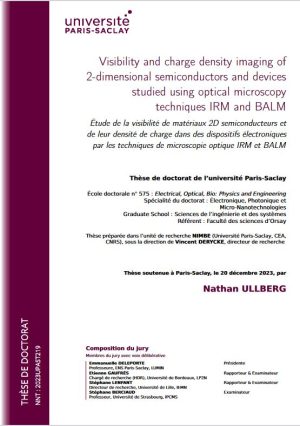Abstract:
Optical microscopy has played an instrumental role in 2-dimensional (2D) materials research. In particular, the phenomenon of thin-film interference of light has been leveraged to improve contrast and vertical resolution of 2D materials down to the sub-nanometer scale, often via Fabry-Pérot (FP) thin-film resonators.
In this thesis, interference reflection microscopy (IRM) and backside absorbing layer microscopy (BALM), both of which harbor FP effects, are developed and utilized to study visibility and topographic inhomogeneities of the 2D semiconductor MoS2. Experimental contrast data are compared against Fresnel-based simulations of contrast. For IRM, an optimal configuration was found by tuning of incident wavelength and top medium refractive index, yielding ≈ 80% contrast. For BALM, the optical properties were measured for both the anti-reflective absorbing layer of nanometric Cr/Au, and an additional insulating AlOx layer, where for the first time the contrast spectrum for this system was acquired and simulated, yielding a maximum experimental contrast of ≈ 79% for 2D MoS2 .
Simulations of the optical stack across a variable range of aperture stop diameters and FP layer thicknesses predict further improvement of BALM conditions for high-contrast MoS2 visibility. Additional aspects including z-focus, optical noise, image post-processing, and others were also considered. Building on the visibility aspects, a charge density imaging capability for 2D MoS2 and other transition metal dichalcogenide crystals was developed by leveraging the charge-dependent complex refractive index near the wavelengths of the excitons.
Capacitors and field-effect transistors (FET) of MoS2 were realized, with multiple in operando experiments performed in widefield at throughputs up to 4 fps. In IRM mode, a liquid electrolyte gate was used, where charging delays and inhomogeneities due to intra- and inter-flakes resistances in polycrystalline MoS2 are presented. For Schottky barrier MoS2 FETs, the drain versus gate voltage competition for control of the local charge density in the channel was studied for the first time by optical microscopy. Solid-state MoS2 capacitor devices integrated in a BALM optical stack are also presented for the first time, both by experiments and simulations. A preliminary solid-state FET device was realized, exemplifying the powerful idea of combining optical charge imaging with electrical characterization in tandem.
This work on visibility and charge imaging aspects aims to widen the role and impact of optical microscopy techniques in the space of 2D materials research.
Keywords: 2D materials, TMD, MoS2, Interference reflection microscopy (IRM), BALM, Field-effect transistor.
Étude de la visibilité de matériaux 2D semiconducteurs et de leur densité de charge dans des dispositifs électroniques par les techniques de microscopie optique IRM et BALM
Résumé :
La microscopie optique a joué un rôle déterminant dans la recherche sur les matériaux bidimensionnels (2D). En particulier, les phénomènes d’interférences dans des couches minces ont été exploités pour améliorer le contraste et la résolution verticale lors de l’observation des matériaux 2D et ce jusqu’à l’échelle sub-nanométrique, souvent par l’intermédiaire de résonateurs Fabry-Pérot (FP).
Dans cette thèse, la microscopie IRM (interference reflection microscopy) et la microscopie BALM (backside absorbing layer microscopy), qui abritent tous deux des effets FP, sont développées et utilisées pour étudier la visibilité et les inhomogénéités topographiques du MoS₂ bidimensionnel. Les données expérimentales de contraste sont comparées à des simulations. Pour l’IRM, une configuration optimale est proposée en ajustant la longueur d’onde incidente et l’indice de réfraction du milieu supérieur, ce qui permet d’obtenir un contraste de ≈ 80%. Pour la technique BALM, les propriétés optiques sont mesurées à la fois pour la couche absorbante antireflet de Cr/Au nanométrique et pour une couche isolante supplémentaire d’AlOₓ. Pour la première fois, le spectre de contraste de ce système a été mesuré et simulé, ce qui a permis d’obtenir un contraste expérimental maximal de ≈ 79% pour le MoS₂ 2D.
Des simulations supplémentaires de l’empilement optique sur une gamme variable d’ouvertures du diaphragme et d’épaisseurs des couches FP prévoient une optimisation possible des conditions BALM pour un contraste encore augmenté. D’autres paramètres ont également été pris en compte, notamment la focalisation en z, le bruit dû aux chemins optiques parasites, les traitements d’image, etc. En s’appuyant sur ces études de contraste, une technique permettant d’imager la densité de charge dans le MoS₂ 2D et d’autres cristaux de dichalcogénures de métaux de transition a été développée. Celle-ci exploite la dépendance de l’indice de réfraction complexe en fonction de la charge aux longueurs d’onde proches de celles des excitons.
Des condensateurs et des transistors à effet de champ (FET) en MoS₂ ont été fabriqués et de multiples expériences in operando ont été réalisées. En mode IRM, une grille électrolytique a été utilisée. Cela a permis de visualiser les délais et les inhomogénéités de chargement dus aux résistances intra- et inter-feuillets du MoS₂ polycristallin. Pour les transistors à effet de champ en MoS₂ (de type Schottky) la compétition entre les tensions de drain et de grille pour le contrôle de la densité de charge locale dans le canal a été étudiée pour la première fois par microscopie optique. Des condensateurs en MoS₂ à l’état solide intégrés avec l’empilement antireflet en conditions BALM sont également présentés pour la première fois, expérimentalement et au travers de simulations. Un dispositif transistor à l’état solide préliminaire a enfin été réalisé, illustrant les mérites de combiner à l’avenir l’imagerie de charge et les mesures électriques.
Ce travail sur les aspects de contraste amélioré et d’imagerie de charge vise à élargir le rôle et l’impact des techniques de microscopie optique dans le domaine des matériaux 2D.
Mots-clés : Matériaux 2D, TMD, MoS2, IRM, BALM, Transistor à effet de champ
NIMBE/LICSEN




